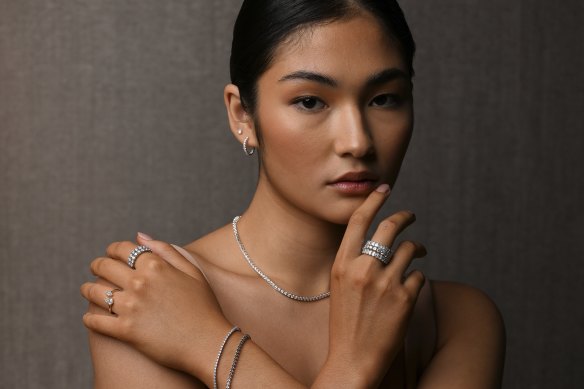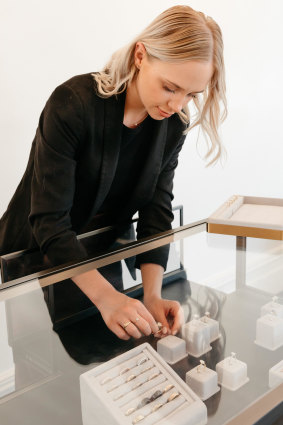The tradition of a diamond engagement ring was important to business analyst Nadia Tamariki on her journey to married life. Less important was the tradition of using mined diamonds.
“We had originally looked at normal diamonds, but the price was not achievable, so we started looking into the moissanite and lab diamonds,” Tamariki says.

Model Kristena Seedwell wears a selection of Michael Hill’s new range of lab-grown diamond jewellery, including 1.8 carat tennis bracelet ($2,659) and 3.5 carat emerald-cut eternity ring ($7,999), at the company’s head office in Brisbane.Credit: Dan Peled
Moissanite is a lab-grown stone with sparkling properties similar to diamonds, while lab-grown diamonds, are chemically identical to the mined variety.
“I originally ordered a moissanite ring, but I changed my mind the next day,” says Tamariki, who purchased her 1.05-carat ring from Brisbane-based The Moissanite Company. “The cost wasn’t that different and now I can confidently say it’s a diamond.”
“I’m no expert, but I can’t tell the difference between it and a normal diamond by looking at it.”
That might because you can’t see the pricetag.
According to IIXIIST swimwear designer Rebecca Klodsinky, who launched her jewellery business The Prestwick Place in 2022, the lab-grown equivalent to a $150,000 mined three-carat diamond will set you back $30,000.
Jewellery start-ups like The Prestwick Place and The Moissanite Company are partly responsible for global sales of lab-grown diamonds rising from 2 per cent in 2018 to 10 per cent last year, according to diamond analyst Paul Ziminsky.
“We had humble beginnings, hoping to craft 50 rings in our first year,” says Makayla Donovan, who launched The Moissanite Company in Brisbane fresh from completing her business degree four years ago. “The demand was so big that in our first financial year we had $1.1 million in revenue. We expect to hit $3.6 million for this financial year.”

Makayla Donovan, founder of The Moissanite Company, which has expanded into lab-grown diamonds.
“It’s a digital age, so customers are coming to us with a strong understanding of what they’re after. Many of them have ethical concerns about mined diamonds, while for others it’s very much about budget and achieving that high impact.”
With the global market value of lab-grown diamonds predicted to rise from $US22.45 billion ($33.88 billion) in 2022 to $US37.32 billion ($56.32 billion) by 2028, big players are also on board. Luxury conglomerate LVMH has invested in Israeli lab-grown diamond start-up Lusix through their venture arm, and mining giant De Beers signalled a ceasefire in their opposition to the rival category by launching their lab-grown division Lightbox in 2018.
In Australia, Michael Hill, which has about 145 stores locally, has flirted with lab-grown solitaire diamond engagement rings for two and half years, but is now committing to the category by expanding into earrings, necklaces and tennis bracelets.
“We haven’t made a big noise about lab-grown diamonds until now because we have been growing our capabilities and understanding,” says Michael Hill chief executive Daniel Bracken. “When the bulk of your business is mined diamonds you need to be careful with the introduction of a new source. It needs to be managed appropriately.”
Lab-grown diamonds currently makes up 6 per cent of Michael Hill’s diamond sales, with Bracken confident the figure will reach 10 per cent with the extensive new collection.
“Diamond giant De Beers convinced the world that mined diamonds were a symbol of timelessness and permanence, but now there’s a growing number of customers looking for choice. They’re interested in sourcing and scale. It’s pretty much about more bang for your buck.”
Lab-grown diamonds may avoid many of the environmental and labour concerns surrounding mining, but require energy-intensive production, and consumers are encouraged to look into their supply chain.
In 2021, environmental auditor SCS Global launched the SCS-007 standard for sustainable diamond certification, with Michael Hill the first major Australian company to jump on board. As a smaller start-up, The Moissanite Company is demonstrating its commitment to sustainability by planting a tree for each ring they sell and by donating a portion of profits to The Australian Marine Conservation Society.
“We are striving towards being as authentic and transparent as possible,” Donovan says.
For some customers, that’s enough.
“I wanted lab-grown because you can get bigger diamonds,” says accountant Melanie Foote, who received a lab-grown engagement ring in April. “It’s attracted nice comments from people at the coffee shop. My fiance did pretty well.”
Make the most of your health, relationships, fitness and nutrition with our Live Well newsletter. Get it in your inbox every Monday.